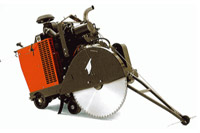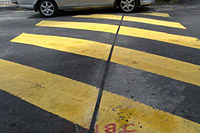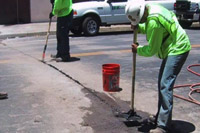

A micro trencher is a "small trenchcutter" specially designed for work in urban or narrow street area. It is fitted with a cutting blade that cuts a microtrench with smaller dimensions than can be achieved with conventional trench digging equipment. Our trench dimensions are widths ranging from about 8 mm to 42 mm, and a maximum depth of about 1000 mm. There are 2 types of micro trencher. One is called a dry-cutter and the other is the wet-cutter. We are currently using the wet-cutter with segmented diamond blades produced locally. Why we prefer the wet cut is that the wet-cutter creates a smooth edged trench whilst the dry-cutter leaves rough trench edges. Obviously it is the same method used to cut a marble blocks, making it smooth around edges and zero dust.With a micro trencher, the structure of the road is maintained and there is no associated damage to the road. Owing to the reduced trench size, the volume of waste material excavated is also reduced.
The process has the following advantages over the conventional processes:
- The rollout of fibre networks is 10 times faster, and therefore, much more cost-effective. Because it is faster, the process is much less disruptive to the public than the old-fashioned method. Duct installation is secure.
- The process has, as a consequence, the development of unskilled labour into skilled labour, especially with regard to equipment drivers and operators, as it requires highly trained and skilled individuals,rather than unskilled labour gangs. In effect, this skills transfer is a form of technology transfer, which can only be to the benefit of all the people of the country.
- The process directly creates opportunities for businesses like asphalt, backfill material, cement and sand suppliers, as well indirect opportunities as for the ancillary suppliers to the main suppliers contracted to TTE.
How to backfill after Microtrenching?
- After a good microtrenching process is done, a road cleaning process comes along using only water jet to remove dirt and particles out from the microtrench.
- Next, we lay sand bedding then the microduct and finally the Cold Asphalt.
- The Cold Asphalt works great even on wet road surfaces as its patented technology explains here.
Why use a Microtrencher?
Micro trenchers are used to minimize traffic or  pedestrian disturbance during network laying. It may also be used to install FTTx connections. Indeed, a Micro Trencher can work on sidewalks or in narrow streets of cities, can cut harder ground than a chain trencher, including cutting through solid stone. They are also used to cut pavement for road maintenance and to gain access to utilities under roads.
pedestrian disturbance during network laying. It may also be used to install FTTx connections. Indeed, a Micro Trencher can work on sidewalks or in narrow streets of cities, can cut harder ground than a chain trencher, including cutting through solid stone. They are also used to cut pavement for road maintenance and to gain access to utilities under roads.
What depth should the micro-duct be installed?
Minimum depth required within NRSWA, New Roads and Streets Work Act 1991, is 20mm into unbound layer. Target depth 150mm hard infrastructure, 250mm soft infrastructure. Actual depth will be determined by the materials found within the structure and depth of third party plant.
What is the recommended installation procedure for the micro-duct?
Most deployments are engineered to be placed between gutter pan and road surface and at a depth whereby the opportunity of network compromise is virtually non-existent. The micro-duct is laid directly into the 12mm or 17mm slot, backfilled to approx. 10mm above top edge of micro-duct with dry sand, limestone composite, flowable concrete or City/Municipal recommended material. Final reinstatement follows guidelines as determined by governing body and may include grade tarmac to approx 40mm of finished surface level followed by hot bitumen to finished level.
How does one locate a damaged or broken
cable? 
In addition to as-built drawings and typical placement of the network between the gutter pan and road, micro-duct contains an aluminum layer or tracer wire that can be used to locate the damaged cable. An OTDR (Optical Time Domain Reflectometer) can also be used to locate damaged fibres.
What happens if the fibre is damaged?
In most cases, if the fibre has been damaged, the micro-duct network has also been compromised. Using specially designed connectors providing an air tight and water tight connection a new section of Micro-duct is connected. The fibre can then be either spliced at the break location or the broken strands blown out and new fibre blown in.


